AMD A10-7800 Review: Testing the A10 65W Kaveri
by Ian Cutress on July 31, 2014 8:00 AM ESTGaming and Synthetics on Processor Graphics
The faster processor graphics become, the more of the low end graphics market is consumed - if the integrated graphics are better than a $50 discrete GPU, there ends up being no reason to buy a discrete GPU. This might seem a little odd for AMD, who also have a discrete GPU business. The counter argument is that integrated graphics is only comparable to low-end GPUs, which are historically low margin parts and thus might encourage users to invest in larger GPUs, especially as demands in resolution and graphical eye-candy increase. The compute side is also important, and the homologation of discrete to integrated graphics architectures helps software optimised for one also be accelerated on the other.
F1 2013
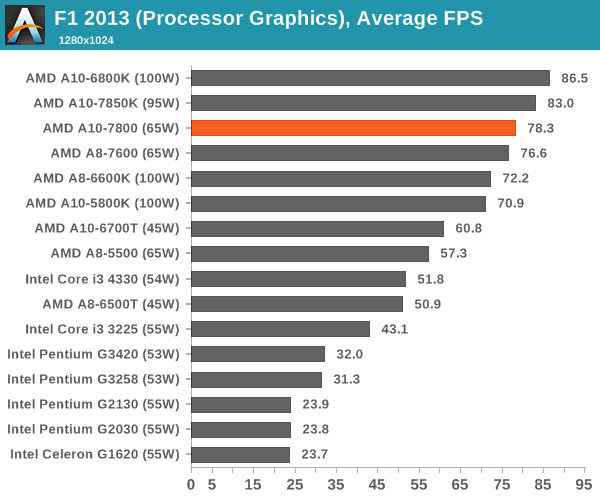
Bioshock Infinite
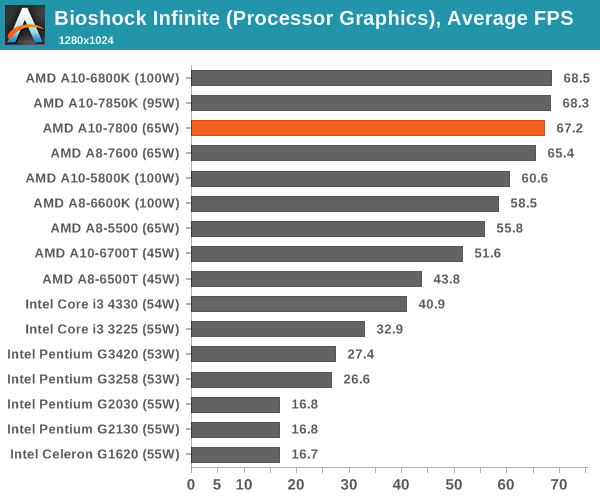
Tomb Raider
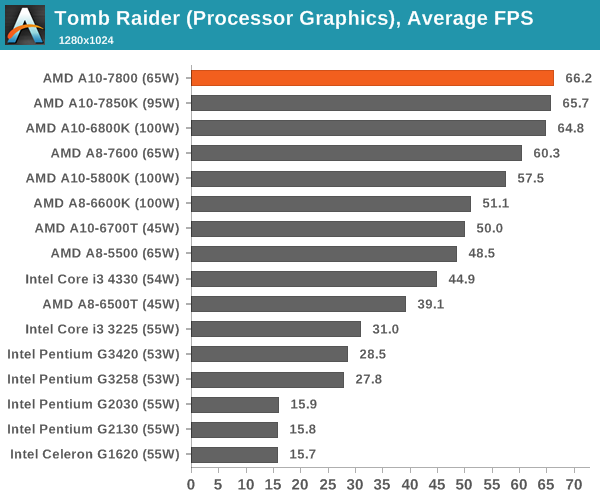
Sleeping Dogs
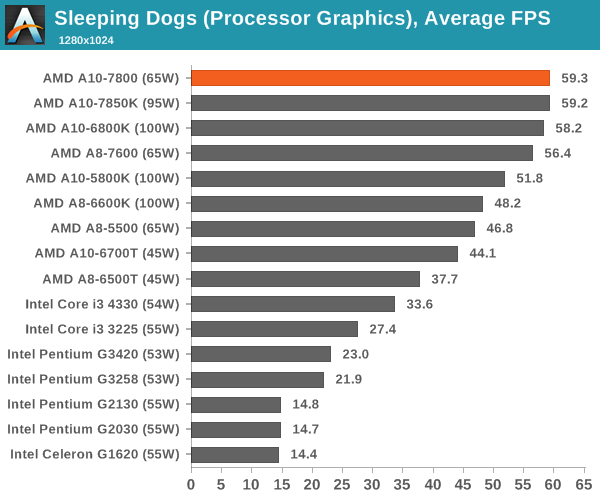
Company of Heroes 2

CompuBench 1.5
CompuBench is a new addition to our CPU benchmark suite, and as such we have only tested it on the following processors. The software uses OpenCL commands to process parallel information for a range of tests, and we use the flow management and particle simulation benchmarks here.
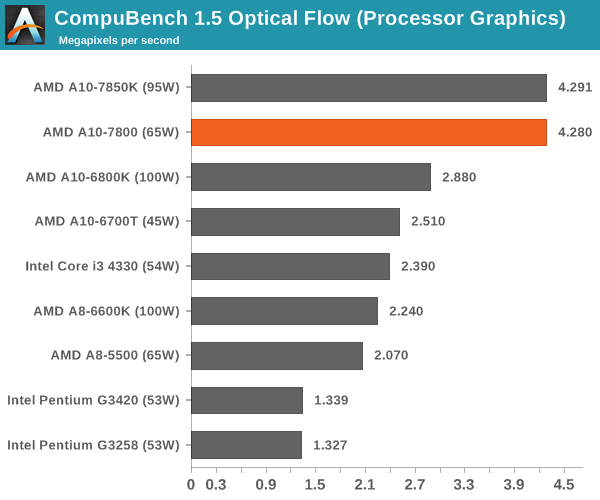
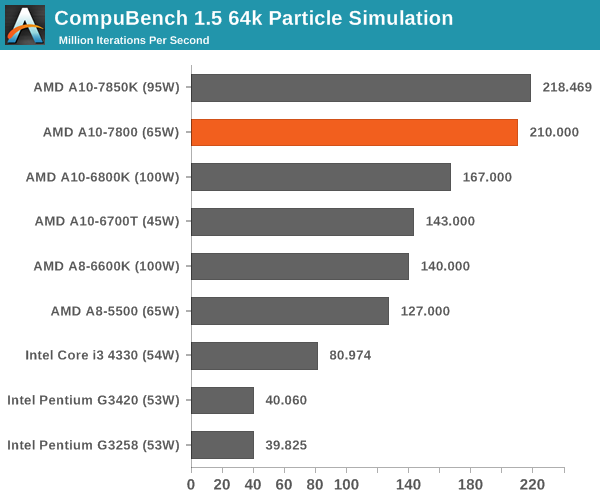
3DMark Fire Strike
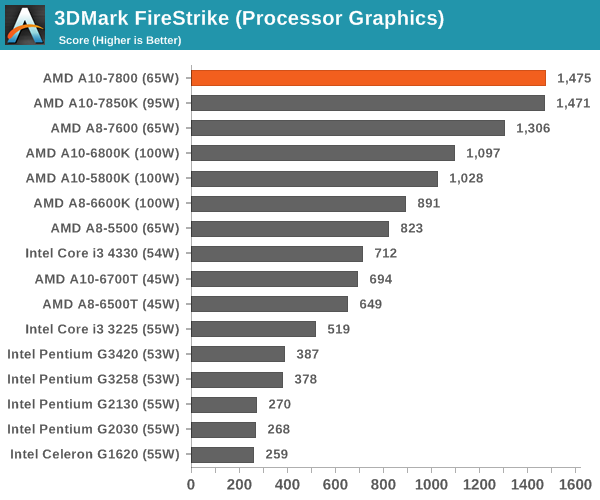
The simple answer is this: for anything related to processor graphics, AMD's Kaveri wins hands down and by a large margin in the same power envelope for cheaper.






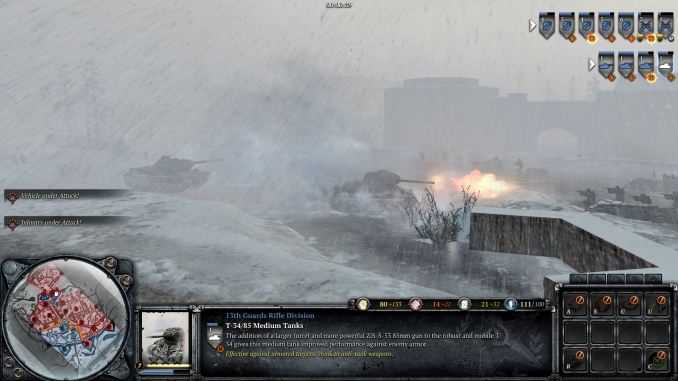








147 Comments
View All Comments
eanazag - Thursday, July 31, 2014 - link
A real budget Desktop PC based on AMD for gaming is going to be the A8-7600. The performance numbers are so close and the processor is also ~$100. The pricing on the 7850K doesn't make sense. The 7800 begins to get reasonable. The A88X chipset is a smidge better than the H87 from a feature standpoint. I think the 7850K should be around $145 and the 7800 around $125. Yes, AMD would take a hit on margin, but I think the volume could be better.tomsworkshop - Thursday, July 31, 2014 - link
the 65W TDP A10-7800 & A8-7600 are good enough for day to day computing + gaming,the intel-i5 may give u 2.5% more performance for the extra 25% cost for day to day computing but not for gaming, u still need to spend more for the dGPU if u wanna games, but that means the cost, TDP, heat & noise and your power bill will be increasing as well.
Andrew Lin - Tuesday, August 5, 2014 - link
again, i don't actually see what you're trying to say here. the system power usage of almost any intel i3 or i5 are a good amount lower than almost anything AMD has, and that's with far higher performance. the same argument about the dGPU can be made about AMD, but with worth propositions because then you've actually bought an APU for absolutely no reason.Andrew Lin - Tuesday, August 5, 2014 - link
that should say "worse propositions"tomsworkshop - Thursday, August 14, 2014 - link
again, we use both Intel CPU (without discrete GPU) and AMD APU here, we see no big different on applications which need a lot computing power, maybe a few second faster on the Intel system, but we see a big different for application that need a lot of graphic power, AMD APU shine on that area. the average joe that buy an system for day to day computing like online, office document, video playback, online games don't even need to computing power from the i5/i7, the core 2 duo or even Pentium 4 can be satisfy for them, you've actually bought an i5/i7 for absolutely no reason.tomsworkshop - Thursday, August 14, 2014 - link
because you are too stupid to understand and see the different or you just a plain blind Intel fanboy sheep, we all know that Intel CPU alone had little bit lower TDP than AMD offering, but the integratedGPU on the Intel CPU sucks big times, anyone in the right mind who build Intel system for gaming will sure need a discrete graphic card by geforce or by radeon, than it totally makes the Intel systems TDP far higher than current AMD 45W/65W APU, we already see that the 45W/65W A8-7600 can handle many modern games on medium setting, that pretty amazing for building a cybercafe gaming rigs, the owner with 50-100 units gaming rig build with AMD 45/W/65W APU will make profit and save money from cut down a lot power cost, the single chip AMD APU will also produce less heat than the intel cpu + discrete gpu, less heat in the cybercafe means less air condition needed = less power = cost saving, the single chip AMD APU will also produce less noise than the intel cpu + discrete gpu, less noise in the cybercafe lead to better environment quality for the cybercafe, that's make the big different which the kids like you can even see.max1001 - Thursday, July 31, 2014 - link
Why in the world would someone buy an APU to get dGPU?tomsworkshop - Thursday, July 31, 2014 - link
lower power consumption, less noise and heat, small form factor, console size gaming rig and htpcJon Tseng - Friday, August 1, 2014 - link
Catch 22:1) AMD kicks ass if you want to game on integrated graphics only.
2) If care about gaming you'd never use integrated graphics only.
Therefore AMD's kickass integrated performance is only available people who don't care about gaming and don't need AMD's kickass integrated performance.
mrcaffeinex - Friday, August 1, 2014 - link
I own an A10-7850K and I game on the iGPU exclusively. I primarily play older titles, but the performance is there for what I'm playing: Skyrim, Fallout: New Vegas, Rage, even a little Battlefield 3 from time to time...1080p on high settings for older titles is not only playable on the iGPU, but gets 60 FPS on some titles. What more do you need for HTPC/light gaming duty?
I picked up the APU/Motherboard as a combo at MicroCenter for about $150 after tax. It fits in my slim HTPC case, runs cool (doesn't need the fan ramped up high enough to make it audible) and does what I need it to do.
The problem is that so many people become so focused on one single performance aspect that they overlook the myriad use-cases for these APUs, of which small-form-factor HTPCs are one. The A10-7800 is running the same iGPU with slightly lower-clocked CPU cores for less money, with a lower TDP, making them viable for even more consumers that do not have the need of a dGPU, but still want to do some casual gaming, which I bet encompasses a lot more people than the typically enthusiast crowd that frequents a site like Anandtech...